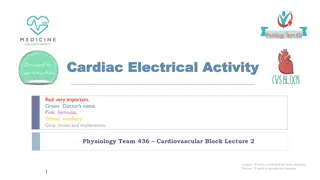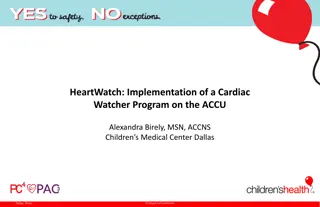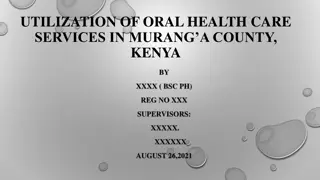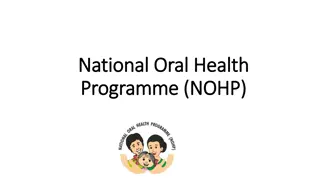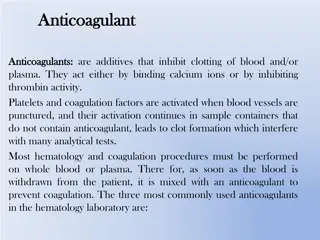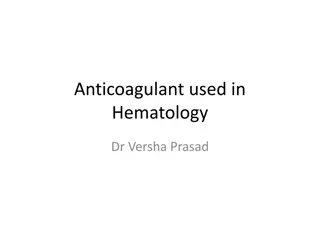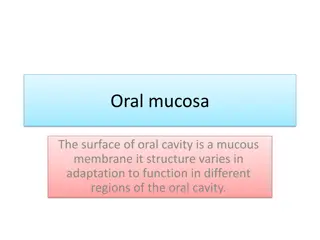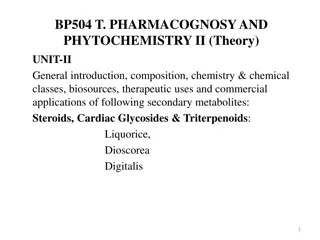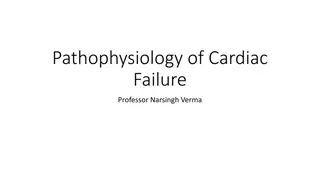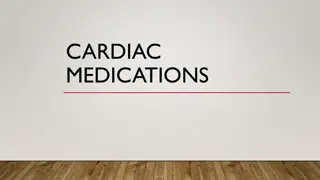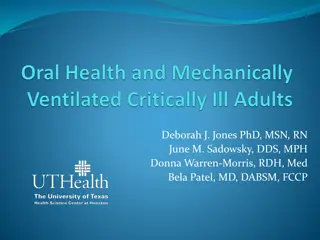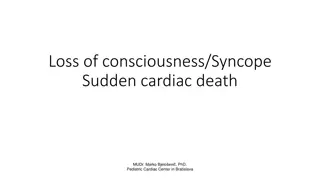Understanding Cardiac Utilization of Novel Oral Anticoagulants
Dive into the realm of cardiac anticoagulation, exploring the evolution from traditional methods like Warfarin to the modern use of Novel Oral Anticoagulants (NOACs). Discover the indications for long-term anticoagulation in conditions like atrial fibrillation and mechanical heart valves. Delve into the significance of risk factors in determining the need for anticoagulation, as highlighted by CHADS2 and CHA2DS2-VASc scoring systems. Gain insights into the dynamic landscape of anticoagulation in the real world, guided by the expertise of Dr. Andrew M. Weinberg.
Download Presentation

Please find below an Image/Link to download the presentation.
The content on the website is provided AS IS for your information and personal use only. It may not be sold, licensed, or shared on other websites without obtaining consent from the author. Download presentation by click this link. If you encounter any issues during the download, it is possible that the publisher has removed the file from their server.
E N D
Presentation Transcript
Cardiac Utilization of the Novel Oral Anticoagulants & Real World Applications Andrew M. Weinberg DO, FACC Upstate Cardiovascular Group
Introduction Why do we anticoagulate cardiacwise Where we were . Why we needed a change Where we are now Where we are going How we use anticoagulation in various clinical settings
Indications for Long-term Anticoagulation Atrial fibrillation Mechanical heart valve or valves Stroke or TIA due to a known patent foramen ovale Prior history of DVT/PE with a known hypercoagulable state (ie Factor V Leiden, Protein C/S deficiency, PT gene mutation AT III or antiphospholipid antibody syndrome) or recurrent unprovoked DVT/PE
Where We Were Vitamin K antagonism was the mainstay of treatment for many years Warfarin/Coumadin for long-term use Once daily dosing despite dose adjustments Easy reversibility in the setting of urgent surgery/bleeding For appropriate patients, adjusted dose Warfarin reduced stroke by 64% compared to placebo without a major increase in bleeding (early AF trials) Compared to 22% stroke reduction for antiplatelet therapy Based upon the above, the Coumadin clinic concept was born
Who Warrants Anticoagulation with Atrial Fibrillation? It is not always beneficial to anticoagulateALL patients with atrial fibrillation as the benefit of long-term anticoagulation may be outweighed by the risk of bleeding Certain risk factors increase the risk of stroke with AF CHADS2 CHA2DS2-VASc
CHADS2 score Appears to acknowledge many appropriate risk factors but are we missing certain populations? Ages? Genders? In an effort to broaden the scope of stroke reduction, the CHADS2 Vasc score is created and now widely used in the inpatient/outpatient settings
Why we needed a change Coumadin can be a difficult drug to manage long-term Time in therapeutic range (TTR) -> in the real life setting, only 1 out of every 4 people are adequately treated Drug-drug interactions Drug-diet interactions Metabolism difficulties with malabsorption, cytochrome deficiencies Non-compliance with multiple changes to medication regimen
The Novel Anticoagulants Are Born! As of the present time, 4 novel anticoagulants are FDA approved to prescribe for stroke risk reduction in the setting of either paroxysmal or permanent non-valvular atrial fibrillation Dabigatran (Pradaxa) Rivaroxaban (Xarelto) Apixaban (Eliquis) Edoxaban (Sayvasa)
Dabigatran (Pradaxa) Approved by the FDA in 2010 Mechanism of action -> direct thrombin inhibitor (DTI) Metabolism via the liver (CYP450 system) Rapid onset of action with half-life approximately 12-17 hours Twice daily dosing 150 mg BID for Creatinine clearance > 30 mL/min 75 mg BID for Creatinine clearance 15-30 mL/min Creatinine clearance < 15 mL/minute & HD not studied/defined Antidote Praxbind Most common side effects include dyspepsia and bleeding
There is a Reversal Agent!!!! Praxbind (Idarucizumab) -> specific reversal agent for Dabigatran approved by the FDA in October 2015 Humanized monoclonal antibody fragment (Fab) that binds to Dabigatran and metabolites with higher affinity than that of Dabigatran to thrombin Reversal indicated for emergency/urgent surgical procedures or life threatening or uncontrolled bleeding Single time use - 2.5 g per 50 mL vial or 5 g IV x 1
Rivaroxaban (Xarelto) Approved by the FDA in July 2011 Mechanism of action -> Factor Xa inhibitor Metabolism via the liver CYP 450 system Half-life of 5-9 hours in most patients and 11-13 hours in elderly 2 doses -> 20 mg daily (Creatinine clearance > 50) and 15 mg daily for 15-50 Too highly protein bound to be removed by dialysis Antidote -> prothrombin complex concentrate (PCC or Kcentra) or Andexxa (Andexanet alfa)
Dabigtran vs. Rivaroxaban Twice daily versus once daily dosing Rivaroxaban better absorbed with evening meal versus Dabigatran not associated with food intake Different mechanisms of action Differences in bleeding
Apixaban (Eliquis) Approved by the FDA in December 2012 Factor Xa inhibitor Metabolized by the liver with half-life 12 hours 5 mg BID for most people including hemodialysis patients 2.5 mg BID suggested if Cr > 1.5 mg/dL, age > /= to 80 and wt < 60 kg Reversal agent Andexxa (AndexanetAlfa) or Kcentra
3 on the marketwhich to choose? 2 Factor Xa inhibitors but now one with superiority data compared to Warfarin (not just non-inferior) BID versus daily dosing with no obvious need to take with food
Edoxaban (Sayvasa) Approved by the FDA in January 2015 Factor Xa inhibitor Metabolized minimally via the CYP 450 system and half-life 10-14 hours Typical dose is 60 mg daily Avoid use in Creatinine clearance > 95 ml/minute Cr clearance 50-95 = no adjustment Cr clearance 15-50 = 30 mg daily Cr clearance < 15 = avoid use
So, where to next ??? Now 5 options available all with benefits and risks There are additional agents currently undergoing investigation What does the practicing clinician do day to day???
Overview of Mechanisms of Action of Novel Anticoagulants
Summary We now have many options to proceed in regarding to stroke reduction in non-valvular atrial fibrillation and there will be more! There are many different considerations The choice of anticoagulant, novel or not, must be an individual decision and made on a case by case basis
Anticoagulation in the Real World Outpatient Asymptomatic versus symptomatic Post procedure Inpatient Post illness /stressor
Case # 1 A 50 year old male with no cardiac risk factors presents for a routine physical exam. He is asymptomatic. He exercises at the gym multiple days per week without difficulty. He has never had a stroke or any known vascular disease. Vitals: BP 120/70 P 90 and irregular Physical exam is normal with the exception of an irregularly irregular pulse An electrocardiogram is obtained
What is your anticoagulation strategy? A. No anticoagulation is necessary as he is asymptomatic and has a CHA2DS2-Vasc score of 0 B. Aspirin 81 mg daily for 30 days only C. It depends upon the future treatment plan D. Lifelong Eliquis 5 mg twice daily E. Call your favorite cardiologist and ask him or her
And the answer is C. It depends upon the future treatment While answer A is indeed correct, it does not take into account the future treatment plan. If direct current cardioversion or ablation is to be performed in the future, it is recommended that the patient be anticoagulated for a MINIMUM of 30 days pre and post procedure. Long-term anticoagulation decision is typically based upon procedure results and future risk (CHA2DS2-Vasc score)
Pre/post procedure anticoagulation Typically, how long does it take thrombus to form within the heart muscle? A. 10 minutes B. 48 hours C. 3 days D. 1 week
Answer B. 48 hours. We typically err on the side of caution and anticoagulate a few weeks before and after to minimize (or hopefully eliminate) the risk of stroke. If the duration of atrial fibrillation for less than 48 hours, cardioversion without TEE may safely be performed off anticoagulation. If the duration of atrial fibrillation is longer than 48 hours or unknown, anticoagulation for 30 days followed by cardioversion without TEE is recommended. If a patient cannot safely be anticoagulated for 30 days prior to a cardioversion or ablation procedure, then TEE must be performed at the time of cardioversion.
Case # 2 A 78 year old female is seen in your office for an acute visit. She has noted exertional dyspnea and lower extremity edema. She is mildly hypotensive (blood pressure 100/60 mm Hg ) and mildly tachycardic in atrial fibrillation at a rate of 120 bpm which is new. She has a history of hypertension and diabetes mellitus. Her cardiologist cannot see her. What is your next course of action? A. Increase her beta-blocker B. Add an ACE inhibitor C. Add Aldactone D. Arrange a TEE guided cardioversion
And the answer is. D. Arrange a TEE guided cardioversion Prompt return to sinus rhythm will not only result in improved hemodynamics but improved perfusion and reduce the patient s likelihood of developing heart failure. None of the other options will definitively result in restoration of sinus rhythm as much as TEE guided cardioversion.
Case #3 A 58 year old male undergoes an elective laparoscopic cholecystectomy. Postoperatively, he develops atrial fibrillation with rapid ventricular response. His heart rate is controlled and he is able to start anticoagulation per the surgeon. He sees you in the office after surgery. He is mildly sore but otherwise feels well and denies cardiac complaints. He has a history of hypertension well controlled on Hydrochlorothiazide only.
How would you manage his anticoagulation? A. Continue anticoagulation indefinitely B. Stop anticoagulation now C. Stop anticoagulation and start Aspirin 81 mg daily D. Continue anticoagulation for 30 days and arrange for direct current cardioversion E. Start Aspirin 81 mg daily in addition to anticoagulation
And the answer is D. Continue anticoagulation for 30 days and arrange for direct current cardioversion. This is typically the easiest approach. Typically, the first 30 days after surgery is considered the vulnerable period. Therefore, protecting the patient against stroke during this time is reasonable. Typically, direct current cardioversion is highly successful in this lower risk population. The duration of anticoagulation remains low and less long-term medical therapy for atrial fibrillation is needed.
Left Atrial Appendage Occlusion (LAAO) Devices Typically indicated in patients who are deemed unsafe to take anticoagulation (bleeding, fall risk, dementia, noncompliance) An elective outpatient procedure performed under TEE guidance Watchman and Amulet are the two percutaneous options (can also be done surgically) Anticoagulation versus dual antiplatelet therapy is recommended 6 months post procedure TEE performed at 45 and 90 days post procedure to evaluate for device related leak/thrombus




